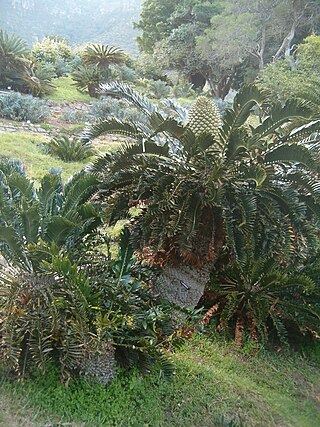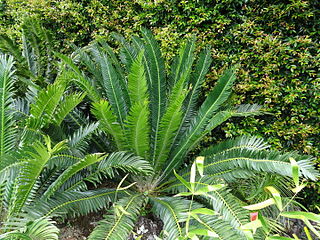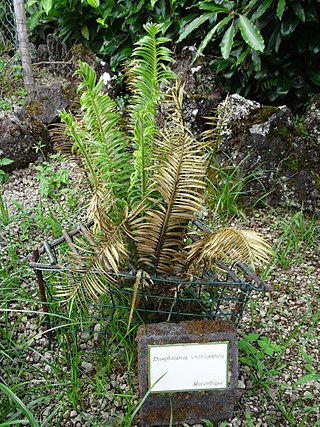
Encephalartos trispinosus is a species of cycad that is native to the Eastern Cape Province of South Africa.

Encephalartos princeps is a species of cycad that is native to Eastern Cape Province of South Africa.

Encephalartos latifrons is a species of cycad that is native to Eastern Cape province in South Africa at elevations of 200 and 600 metres.

Encephalartos gratus is a species of cycad that is native to Malawi and Mozambique.

Encephalartos eugene-maraisii is a species of cycad in the family Zamiaceae. It is endemic to South Africa, where it is limited to Limpopo. It is known as the Waterberg cycad.

Encephalartos cycadifolius is a species of cycad that is native to the Winterberg mountains to the north of Bedford in the Eastern Cape province, South Africa. It is found at elevations from 1,200 to 1,800 meters.

Encephalartos dolomiticus, the Wolkberg cycad, is a critically endangered species of cycad. It is only found in the Wolkberg at elevations of 1100–1500 meters. The area is near Penge in southeastern Limpopo Province, South Africa.

Encephalartos concinnus is a species of cycad in the family Zamiaceae. It is endemic to Zimbabwe. It is known as the Runde cycad.

Encephalartos hildebrandtii is a species of cycad in the Zamiaceae family. It is native to Kenya and Tanzania at elevations from sea level to 600 metres (2,000 ft). The species is named for the German explorer Johann Maria Hildebrandt.

The Chimanimani cycad is a species of cycad that is endemic to the Chimanimani Mountains of eastern Zimbabwe. It is a threatened species which has been locally extirpated by cycad collectors.
Encephalartos macrostrobilus is a species of cycad in Africa. It is found only in Moyo District, northwestern Uganda, which is populated predominantly by the ethnic Madi.

Encephalartos septentrionalis, the Nile cycad, is a species of cycad in South Sudan, northern Uganda, northern Democratic Republic of the Congo, and the interior of the Central African Republic.
Encephalartos mackenziei is a species of cycad in South Sudan. It is found in the Didinga Hills of Namorunyang State.

Encephalartos aplanatus is a species of cycad in Eswatini.
Encephalartos dyerianus, known colloquially as the Lillie cycad, is a species of cycad that is native to hillsides in the lowveld of eastern Limpopo, South Africa.
Encephalartos heenanii is a species of cycad in Southern Transvaal Province, South Africa.

Encephalartos lanatus is a species of cycad, a plant belonging to the family Zamiaceae growing in Mpumalanga, South Africa. Its specific epithet, lanatus, means wooly in Latin.

Encephalartos nubimontanus is a species of cycad which is native to Limpopo, South Africa.

Encephalartos umbeluziensis is a species of cycad from Africa.
Encephalartos kanga, also known as Mnanasi Pori is a species of cycad in the family Zamiaceae. It is native to Tanzania. The plant was formally described as a new species in 2007 by Tamás Pócs and Quentin Luke.
















